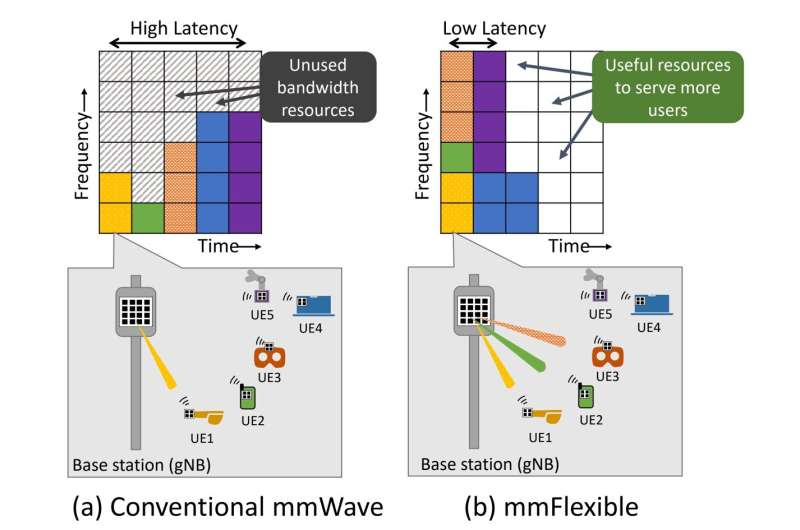mmFlexible enables efficient use of the available mmWave spectrum resources through flexible directional-frequency multiplexing, allowing multiple users to be served simultaneously with low latency and high spectrum utilization. Credit: arXiv (2023). DOI: 10.48550/arxiv.2301.10950
A new paper on wireless connectivity from the lab of Dinesh Bharadia, an affiliate of the UC San Diego Qualcomm Institute (QI) and faculty member with the Jacobs School of Engineering's Department of Electrical and Computer Engineering, introduces a new technique for increasing access to the 5G-and-beyond millimeter wave (mmWave) network.
"Energy grids and mmWave/sub-THz networks share a remarkable similarity; both face fundamental challenges in efficient distribution," said Bharadia. "Just as energy grids generate substantial amounts of energy but encounter significant hurdles in efficiently delivering it to homes, the utilization of mmWave/sub-THz networks for seamless data connectivity presents a similar predicament. Despite abundantly available bandwidth in these spectra, the efficient distribution of data with these spectra to user devices remains a formidable challenge."
The paper, "mmFlexible: Flexible Directional Frequency Multiplexing for Multi-user mmWave Networks," was presented by Ph.D. student and lead author Ish Kumar Jain at the IEEE International Conference on Computer Communications in New York on Wednesday, May 17.
Sharing access
With the introduction of more automation and greater speeds and processing power behind wireless networks, the infrastructure that connects people to these resources has fallen behind.
Jain was drawn to the challenge of creating a device that could bridge this gap and give people greater access to the 5G mmWave network.
5G mmWave systems use radio frequencies to connect everything from "smart" cars to handheld devices and virtual reality sets to wireless networks. The advancement from 4G to 5G allows for higher speeds and bandwidth overall.
Part of the problem, Jain says, is that the jump from 4G to 5G opened up far more resources and processing power than existing infrastructure could handle. mmWave systems depend on a "pencil beam" distribution model in which a base station sends out a single beam of coverage, like shining a light in the dark. Everyone within that beam has access to all resources that the 5G mmWave network has to offer, regardless of whether their devices can process them.
This can lead to a waste of bandwidth that might otherwise have been leveraged by users in other regions. Even shifting this beam, like a lighthouse rotating slowly at timed intervals, creates lag for those who fall beyond its range.
To address the combined issues of wasted bandwidth and lag, Jain, Rohith Reddy Vennam and Raghav Subbaraman, also Ph.D. students in Bharadia's Wireless Communication, Sensing and Networking Group (WCSNG), set out to determine whether they could create an antenna array that served users in multiple directions without sacrificing distance and power.
The team designed a prototype device that works in concert with a novel array of antennas to divide a single frequency band into multiple usable beams. Called a delay phased array, this antenna arrangement leverages 5G mmWave's sheer amount of bandwidth to connect multiple regions to the network and can be tailored to deliver greater connection to those who need it.
This new, programmable array can also be built using existing technologies and scaled up with a very high number of antennas to support all future devices.
Through experiments run in QI's Atkinson Hall on the UC San Diego campus, the team found mmFlexible decreased lag by 60-150%.
"It's very exciting to see new generations of applications coming up," said Jain. "But I feel, in the future, the number of [wireless] devices will grow and so will their demand for wireless spectrum. These are the key things that motivate me to further explore these innovative techniques."
The research is published on the arXiv preprint server.
More information: Ish Kumar Jain et al, mmFlexible: Flexible Directional Frequency Multiplexing for Multi-user mmWave Networks, arXiv (2023). DOI: 10.48550/arxiv.2301.10950
Conference: infocom2023.ieee-infocom.org/
Journal information: arXiv
Provided by University of California - San Diego
























